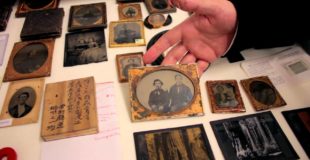The history of photography is rich with chemical innovations and insights, producing hundreds of different processes to develop images in unique and often beautiful ways. But these historical images can be difficult to conserve, especially since each type of photograph requires a different preservation technique. While two photos could look very similar, they may differ chemically in dramatic ways.
This is where photo conservation scientists like Art Kaplan at the Getty Conservation Institute come into the picture. Art spends his days studying different styles of photographs, their materials and the chemistry that gave life to still life in the early days of photography. His office is loaded with drawers of photographic samples, scientific instruments and a clear passion for frozen history. In our latest video, Art explains the developmental processes of several types of photographs including daguerreotypes, ambrotypes and tintypes.
Video by Kirk Zamieroski
Produced by the American Chemical Society
Original source

5 responses to “A Brief History of Photography: Innovations in Chemistry – Bytesize Science”
this was very interesting and you explained it very well!
the music is great too
what the hell happened to your thumb! D:
Lol at the blurry kids!
Now I want to go look up all the different chemicals experimented with in photography.
Cool stuff, thanks!